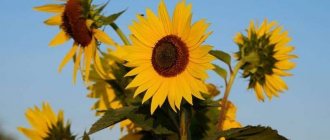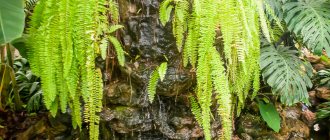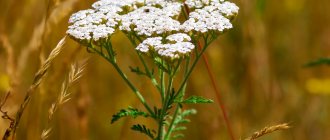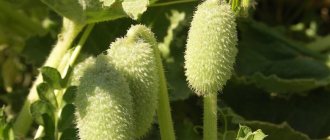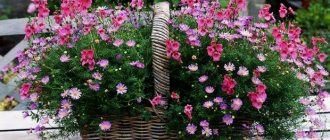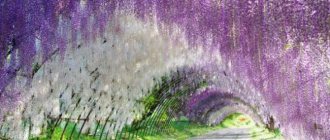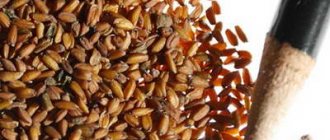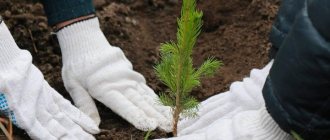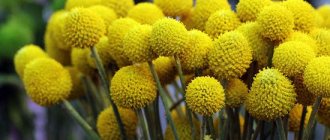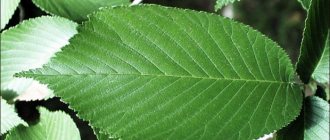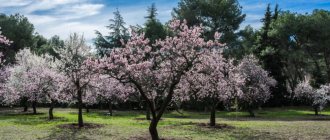FERN Adiantum
Family Pteridaceae
The name of this type of indoor fern comes from the Greek words: “a” - “not” and “diant” - “to wet”. Due to the hydrophobic property of the surface of the leaf blade of these ferns, droplets of water flow from the leaves without wetting them. The genus Adiantum has more than 200 species distributed throughout the globe. Representatives of this type of fern grow in the form of low bushes formed by somewhat drooping double-pinnate leaves (fronds) with wedge-shaped lobes. Sori (formations in which spores develop) are located at the ends of the veins along the edges of the feathers and are covered with a rolled edge that looks like a brownish film.
Indoor adiantums require high air humidity. warmth and dim lighting. Adiantums should not be placed in direct sunlight. In winter they are kept at a room temperature of at least 20 °C. Lower soil temperatures and drafts are detrimental to the plant. Unlike other types of ferns, maidenhair prefer neutral or slightly alkaline soil mixtures.
The earthen ball under the fern should be moist all year round, but neither excess water in the pot nor the soil should be allowed to dry out. Indoor air humidity is created by constantly spraying water over the plant, but without spraying it directly. For irrigation use soft water at room temperature. From time to time, the pot of adiantum should be immersed in water.
Adiantums reproduce vegetatively and with the help of spores. Adiantums look good next to low-growing astilbes, primroses, anemones, and autumn crocuses.
Adiantum capillus veneris L.
In nature, it grows in temperate, subtropical and tropical regions of Eurasia and South Africa. It grows in crevices of limestone rocks, along river banks, and in forests. In indoor culture it is the most common and favorite among ferns. The dark elastic petioles of its leaves really look like hair. Adiantum Venus hair is a plant with amazingly beautiful finely dissected pinnate leaves, with wedge-shaped leaves on short brown hairy petioles. The petioles themselves are brown or black, with a shiny, as if varnished, surface.
The sori of the fern are transversely oblong, elongated along the edge of the leaf segment. This part of the segment bends down, and the sori end up in the “pocket”. The plant does not tolerate dry air well and needs frequent spraying.
Adiantum Venus hair can grow in shaded areas. The required temperature in winter is -16-20 °C. Feeding is required once every six months, in spring and summer.
Adiantum pe datum L.
It grows naturally in North America and East Asia. Maidenhair plant is a beautiful plant up to 60 cm tall with flat fan-shaped leaves on thin shiny black petioles. The stems bend to form a horseshoe. Winter-hardy plant.
Beautiful adiantum (Adiantum formosum R. Br.)
This plant is native to the humid subtropical forests of Australia and New Zealand. The beautiful adiantum is a large plant, reaching 1 m in height. The leaf blades of this fern are broadly triangular, multipinnate, on very long purple-black petioles. The segments are dark green, on rusty pubescent petioles. The sori are kidney-shaped, located in the upper part of the segments. The beautiful adiantum requires special care when transplanting due to its very fragile rhizome.
Adiantum bispidulum Sw
In nature, this fern grows in humid subtropics and tropics. Adiantum finely pubescent is a small plant with a creeping rhizome. Leaves are double-triple pinnate, 15-20 cm long. The segments are rigid, broadly diamond-shaped or rounded-obverse triangular, pubescent on both sides. The petiole is 15-35 cm long, brown, finely bristly and pubescent. Sori are horseshoe-shaped, located at the ends of the veins
How to care for a fern?
Ferns are an ideal option for those gardeners who dream of beautiful but low-maintenance plants. Fern care is minimal. He will be immensely grateful to you if you:
- water: do not forget that fern is a moisture-loving crop;
- mulch: this will help the soil stay moist longer;
- loosen: fern loves light soils saturated with oxygen;
- thin out: every few years the bush must be thinned out and, if necessary, replanted;
- clean up: all dried fronds need to be trimmed and removed from the site every autumn.
The fern grows well without fertilizers. However, if you decide to feed him anyway, he will be grateful to you. It is better to apply both mineral and organic fertilizers in the spring.
Fern still doesn't grow in your area? It's time to correct this shortcoming.
Fern Asplenium (Kostenets) - Asplenium
Family Aspleniaceae
Asplenium is an extensive genus of ferns with a short rhizome and spreading double-pinnate fronds. Asplenium is a perennial plant that grows naturally on rocks, walls and rocky forest soils in Europe, Asia and America. This fern is an epiphyte; it reaches enormous sizes - its leaves are a meter in size. About 700 species are known. Species of tropical origin are usually grown indoors.
The name of the plant comes from the Greek words "a" - "not" and "splen" - "spleen" and is associated with the supposed medicinal properties of these ferns.
Aspleniums need to be fed once every two to three months. From time to time, the pot with the plant needs to be immersed in water. These ferns are propagated mainly by sprouting adventitious buds on fronds. Aspleniums are most often used in shady gardens and rock gardens.
Asplenium nidus
The genus includes about 650 species of herbaceous perennial plants distributed throughout the globe. They grow in tropical forests of Asia, Africa, and Australia. Asplenium nest is a typical epiphyte, settling on large trees and between branches. Indoor Asplenium nesting is unpretentious. The decorative period is all year round. Reaches a height of 70 cm. Leaves are from 15 to 50 cm long, 5-10 cm wide, entire, leathery, sword-shaped, wavy edges, collected in a rosette, bright green, the midrib is brown.
Asplenium nest requires moderate lighting and high humidity, which is achieved by frequent spraying. Temperature - from 16 to 21 °C. Water regularly, not allowing the earthen ball to dry out. This fern reproduces by spores or brood buds, often formed on the upper part of the leaf.
Asplenium viviparum Presl.
In nature, Asplenium viviparous grows on the island of Madagascar, in the Mascarene Islands. Terrestrial perennial rosette plant. The leaves of this fern are short-petiolate, double- and quadruple-pinnate. Leaf length is 40-60 cm, width -15-20 cm.
The sori of Asplenium viviparis are located along the edges of the segments. On the upper side of the leaves, brood buds develop, which sprout on the mother plant. Having fallen to the ground, they take root.
Asplenium bulbiferum Forst
It grows naturally in New Zealand, Australia, and India. Asplenium bulbiferous is a terrestrial species of fern with leaves reaching a length of 1 m. Brood buds are formed on the leaves, from which, under favorable conditions (i.e., high air humidity), small leaves of daughter plants are formed. Separating from the mother plant and falling into moist soil, they take root and give rise to new plants.
Asplenium bulbiferous grows relatively quickly. Feels good on windows facing north.
Australian asplenium (Asplettium australasicum)
It grows naturally in Australia and Polynesia. Australian asplenium is an epiphytic plant with large leaves reaching 1.5 m in length and 20 cm in width. The leaves are collected in a dense narrow funnel-shaped rosette. The leaves are entire, oblanceolate, with the greatest width in the middle or slightly above the middle of the blade, tapering rather sharply downwards, leathery, wavy, light green with a dark purple midrib. The sori are linear, elongated, located obliquely in relation to the midrib. Prefers unshaded places; in winter it can be kept at temperatures not lower than 18. This fern requires abundant watering with soft water at room temperature.
Features of care
Basic care for ferns at home involves regular watering and ensuring sufficient air humidity - most species do not tolerate drought.
It is equally important when caring for ferns at home to ensure optimal temperature conditions and lighting. It is necessary to properly transplant and propagate ferns
If not properly maintained, the indoor flower will quickly die.
If the plant is located near other flowers, it is important to make sure that its delicate lacy leaves are not squeezed. The fronds are very fragile and require free space
If leaves are damaged or dry, they must be removed in a timely manner, allowing young fronds to develop freely.
Indoor fern loves water very much. Prolonged drought can destroy the plant. As soon as the top layer of soil dries out, it needs to be watered. At the same time, excess moisture is harmful to the root system and can lead to the death of the fern. If there is excessive moisture, the leaves become covered with yellow and brown spots, the roots begin to rot, and the plant dries out completely. It needs to be watered several times a week with settled water.
It is important to remember that if a house fern is dried out and then watered, the plant will still not recover.
Illumination
Indoor ferns love good lighting; they may die in the shade. It is best to place the plant on a window on the southwest side. With sufficient access to bright, indirect light, the plant's leaves will be large, green and healthy.
Temperature
The average optimal temperature for a fern flower is from 15 to 22 ° C. But more specifically, the temperature regime must be selected taking into account the plant variety. There are types:
- heat-loving (nephrolepis, asplenium, platycerium) - must be kept in winter at a temperature not lower than 18 ° C;
- resistant to low temperatures (polypodium pimpulata, pellea) - can withstand temperatures down to 12 ° C.
All types of indoor fern-like plants do not tolerate drafts, but they love fresh air. The room with the flower must be ventilated regularly.
The soil for the fern should be loose, well-permeable to air and water, otherwise the moisture will stagnate in the container, which will ultimately lead to rotting of the roots. It is optimal for the soil to contain a large number of rotted leaves, a little less pine needles and peat.
To prevent water from stagnating, place a drainage layer of expanded clay on the bottom of the pot.
Soil with a slightly increased level of acidity (pH from 5.0 to 6.6) is suitable for ferns. Soil acidity can be easily determined using litmus paper. To do this, 2 g of soil must be mixed with 10 ml of distilled water, shake well, and allow the sediment to settle. Then dip litmus paper into the liquid above the sediment. At pH=5 it will turn yellow, and at pH=6 it will turn greenish-yellow.
Fertilizer application
Indoor fern usually grows normally and feels good without additional feeding. But the fact that the leaves of the flower have turned pale and become small indicates a lack of nutrients in the soil.
The need for fertilizing often occurs during the active growth phase - late spring and summer. You can fertilize the flower with liquid complex mineral fertilizers, for example, a solution, 1 liter of which contains:
- potassium salt – 1 g;
- superphosphate – 1.5 g;
- ammonium nitrate – 1.5 g.
Use organic matter on ferns with great caution - it can cause burns. Some gardeners periodically add tea leaves to the pot or water it with weakly brewed tea
The fern plant is a fast-growing plant, and therefore it is replanted every year at a young age. It is recommended to replant adult specimens every 2–3 years. Fern transplantation is carried out in the spring.
In order not to harm the plant, it is advised to replant it into a larger pot using the transshipment method. During transplantation, the base of the rosette of leaves should not be buried in the ground.
The soil from the roots of indoor flowers is not cleaned so as not to damage the fragile roots. An exception is a disease of an indoor flower, in which it is necessary to detect damaged roots and remove them.
The fern is sensitive to the transplantation procedure, and its recovery can take several months.
To transplant ferns, you can buy a ready-made soil substrate with an acidic environment in the store or prepare the soil yourself. To do this you need to take:
- leaf soil - 1 part;
- humus – 1 part;
- peat – 1 part;
- bone meal – 1/5 part.
You can use another primer containing:
- 3 parts each of leaf soil and peat;
- 2 parts of turf land;
- 1 part humus and sand each;
- 1/2 cup ash;
- a handful of sphagnum moss.
Types of fern: Blekhnum (derbyanka)
It grows naturally in New Caledonia and the neighboring Pacific islands. The trunk of this fern reaches 1 m in height. In plants kept in rooms, such sizes are rare.
Blekhnum requires a bright, but cool place protected from direct sunlight. In winter, this fern is kept at a temperature not lower than 16 C. The plant does not tolerate cold and drafts.
In summer, abundant watering with soft water at room temperature is required; the earthen ball should not be overdried. In winter, watering is limited. The plant should not be sprayed frequently. Blechnum reproduces by spores.
Blecbnum spicant
It is found naturally in Western Europe, Transcarpathia on the Black Sea coast of the Caucasus, Japan and North America.
Derbyanka spica is an evergreen fern with feathery, leathery, shiny, sterile leaves. Sporophylls on long petioles with linear sharp segments. In indoor conditions, the plant reaches 20 cm in height. Grows well in humus-sandy soil, requires shade.
Description of the plant
Natural habitat - shady forest valleys, trunks and branches of giant trees (epiphytic species), rock crevices, rivers, swamps and lake areas. The most unassuming species grow in field conditions and on roadsides.
More than 400 million years ago, ferns grew up to 40 m in height.
The main life forms of perennials are herbaceous and woody species. The tropical resident does not like excessive dampness and cold; waterlogging is also contraindicated for him, as is the scorching hot sun. The main conditions are a warm and humid climate.
The body of the plant consists of a leaf plate, a petiole, a shoot and a rhizome. The root system (vegetative and adventitious) is thin and cord-like in structure. The shoots are epiphytic, creeping. Ferns with underground, short stem-roots live in temperate climates.
In a fern, what is commonly called a leaf is a system of branches that is located in the same plane. Hence the name - flat branch, pre-shoot or frond. Fronds are formed from the buds of the rhizome and reach large sizes. Preshoots participate in the process of photosynthesis and form spores.
The fronds are cut, openwork, curved in structure. They grow lushly and spreadingly. They reproduce vegetatively (by rhizomes, fronds, buds) or by spores (microbuds for asexual reproduction).
Fern Davallia Davallia
In nature, it is distributed in the tropical zones of Asia and Australia.
Davallias are epiphytic ferns with creeping terrestrial rhizomes covered with light brown scaly hairs. In indoor conditions, davallias are best grown in hanging baskets, like hanging plants. In winter gardens, these ferns can be attached to pieces of bark, to which thick rhizomes covered with red-brown or silvery scales cling.
Davallia prefers a bright place, but at the same time protected from direct sunlight. In winter, it is kept at a temperature of about 15 ° C and high air humidity, which is achieved by frequent spraying. The soil in the pot should always be moist. Water the plant with soft water at room temperature. Davallia propagates by pieces of rhizomes that take root in moist soil.
Davallia canariensis
This amazing fern attracts with its shaggy rhizomes hanging over the edge of the pot, for which it is often called the “hare's foot”. The leaves look like carrot leaves and have tiny feathers on them. This plant has a creeping rhizome and wire-like petioles.
Diseases
To begin with, it is worth noting that to maintain a chic appearance, the fern needs to be trimmed periodically. The old drying leaves from below are removed, and some new shoots are cut off. All this is done so that the fern devotes all its energy to the succulence of the main leaves, and not to the growth of new ones or to the so-called processing of old ones.
But there are more serious problems that you may encounter when growing ferns at home:
- The fern stopped growing. This usually means that its roots in the pot have become cramped; it’s time to transplant the plant to a slightly more spacious place.
- The leaves of the fern are drying up. This is a sign that there is not enough humidity in the room. And perhaps there is not enough watering.
- The fern leaves darken and become spotted. Surely the plant has developed fungus or root rot due to excess water. It is imperative to remove the fern from the pot, inspect the root shoots, and cut off all darkened and limp parts. Next, treat with a fungicide solution and transplant into a new substrate. In the future, be careful with watering.
Sometimes foreign marks are noticed on the fern, indicating the presence of pests. For example:
- Whitish lumps indicate the appearance of a mealybug.
- The thin web is formed by spider mites.
- Brown, stubborn spots are left by the scale insect.
All these insects, as a rule, appear due to the same problem - insufficient watering and moisture. If pests appear, you need to deal with them immediately.
Washing a fern with soapy water will be a rather difficult procedure due to the many small patterned leaves, so you should immediately take up strong chemicals to control pests of indoor plants.
Kochedyzhnik fern (Athyrium)
Distributed in temperate forests of both hemispheres, less often in the highlands of the tropics. The genus includes up to 200 species. Most often these are plants reaching 1.5 m in height, they have straight ascending or creeping membranous rhizomes and dense black roots.
Leaves are double- or triple-pinnate with pinnately divided or pinnately dissected pinnae, less often simple or single-pinnate. The leaves are collected in a bunch.
They reproduce vegetatively and by spores. For vegetative propagation, sections of creeping rhizomes 20-25 cm long with two buds are used. Ferns can be replanted and divided in early spring, before the leaves grow, or in the first half of August, during the ripening of the spores. Ferns grown from spores develop into more powerful and resilient plants.
Kochedyzhnik looks good both in pots and in compositions. It is recommended to plant low plants that bloom in the spring under the canopy of the nomadic plant.
Female stumpweed (Atbyrium filix-femma (L.)
It grows naturally in the temperate zone of the Northern Hemisphere.
Female kochedyzhnik is a perennial plant reaching 1 m in height. The leaves of this fern are large, delicate, light green, on yellowish-green or reddish petioles, making up about half of the leaf blade. The leaf blade is lanceolate or elliptical in outline, double- or triple-pinnate with serrated lobes or segments. The leaves are collected in a rosette. The rhizome is short, thick, densely covered with brown membranous hairs. Spores begin to appear in mid-summer.
This fern prefers shaded areas with high humidity.
Atbyrium spinulosunt
In nature, it is found in coniferous and mixed forests of the Far East, where it forms extensive thickets 30-40 cm high.
The leaves are openwork, diamond-shaped, horizontally located, raised on thin, hard petioles. In winter the leaves fall off. The rhizome is creeping, thin, branched. The root system is superficial and weak, so you should be especially careful when transplanting this fern.
The plant requires loose soil. Grows well in shaded areas with high humidity, which is achieved by frequent spraying. Reproduces by spores and division.
Red-petioled moth (Atbyrium rubripes)
A plant with reddish leaves and brown-red petioles. Prefers shaded places with high humidity. Plants are well suited for decorative compositions located in the shade of trees in winter gardens.
Alpine stumpweed (Athyrium distentifolium Roth)
In nature, it can be found in mountain meadows of the subarctic zone of Europe, Asia and North America.
Alpine kochedednik is a perennial plant reaching 70 cm in height. This fern has three-pinnately dissected leaves, collected in a rosette. In winter the leaves fall off. The plant has a short rhizome. t A moisture-loving plant that prefers not too shaded places. The decorative period is from spring to autumn.
Transfer
The fern plant is a fast-growing plant, and therefore it is replanted every year at a young age. It is recommended to replant adult specimens every 2–3 years. Fern transplantation is carried out in the spring.
In order not to harm the plant, it is advised to replant it into a larger pot using the transshipment method. During transplantation, the base of the rosette of leaves should not be buried in the ground.
The soil from the roots of indoor flowers is not cleaned so as not to damage the fragile roots. An exception is a disease of an indoor flower, in which it is necessary to detect damaged roots and remove them.
To transplant ferns, you can buy a ready-made soil substrate with an acidic environment in the store or prepare the soil yourself. To do this you need to take:
- leaf soil - 1 part;
- humus – 1 part;
- peat – 1 part;
- bone meal – 1/5 part.
You can use another primer containing:
- 3 parts each of leaf soil and peat;
- 2 parts of turf land;
- 1 part humus and sand each;
- 1/2 cup ash;
- a handful of sphagnum moss.
Fern species: Leaf fern (Phyllitis Hill).
This type of fern includes about 10 species of ferns, distributed mainly in the Northern Hemisphere. The name comes from the Greek word “phyllon” - “leaf”, which indicates the peculiar shape of its leaves.
Leaflet is a plant with a short straight rhizome covered with films; the leaves are collected in a bunch. It differs from numerous members of the family by whole or slightly lobed, leathery, overwintering leaves. The leaves reach a length of 20 to 40 cm and a width of 4–5 cm. The sori are located in pairs on the underside of the leaf and, until ripe, are covered with a membranous blanket that protects them.
Prefers shady and cool places. The soil should be moderately moist throughout the year. If the room has dry and warm air, the fern is immersed in wet peat or placed on a tray with water. Propagated by division of rhizomes, cuttings and spores.
In nature, it is found on shaded rocks in the forests of the Caucasus, Southern Europe, Asia and North America. Scolopendra leaf is a perennial fern, reaching 60 cm in height, it has a thick rhizome, densely covered with scales. The leaves are entire, lanceolate or tongue-shaped, entire, sometimes irregularly cut, wavy, with a medullary base. The sori are located in pairs along the entire leaf. The spores ripen in the second half of summer. This fern reproduces vegetatively and with the help of spores.
Biological characteristics
Ferns are perennial vascular plants characterized by the predominance of leafy sporophytes in their life cycle. The gametophyte is quite primitive and serves only to carry out one of the stages of reproduction.
Ferns have all the typical vegetative organs (stem, root and leaf), but some representatives lack an aboveground stem. Plants of this group have 2 life forms: herbaceous (characteristic of most species) and woody. The latter is found only in tropical forests. These varieties of ferns have a developed ground stem up to 25 meters high. The absence of this vegetative organ is characteristic of some species of temperate continental flora.
According to their environmental characteristics, biological species of ferns and the names of their cultivated varieties are divided into three groups:
- forest;
- rocky;
- swamp.
Ferns are spore plants and not angiosperms. That's why they never bloom.
Centipede (Polipodium)
This genus of ferns includes about 300 species. The name comes from the Greek words “polys” - “many” and “podos” - “foot”. Most often these are epiphytes, less often - terrestrial herbaceous ferns with creeping scaly rhizomes, on the upper side of which there are leaves on jointed petioles in two rows. The leaf blade is dense, bare, sometimes overwintering. Prefer moist, shady places. They reproduce vegetatively and by spores.
Common centipede (Polipodium vulgare L)
In nature it grows on rocks and in the forests of Europe. Asia and North America.
It is an evergreen fern with leathery, palmetto-compound leaves reaching 20 cm in length. The rhizome is creeping, covered with golden-brown scales. The sori are located in two rows along the central vein, initially they are golden in color, then become darker. The spores ripen in the first half of summer.
Ussuri centipede Polipodium ussuriettse
It is found naturally in the Far East, growing on tree trunks and rocks. Ussuri centipede is an epiphytic fern. Its leaves are dark green, lanceolate, entire, and in dry weather they curl into tubes. Reproduces by spores.
Polystychum Roth.
The genus includes about 175 species, widely distributed throughout the globe. The name comes from the Greek words “polys” - “many” and “stichos” - “row”.
Polyrowed ferns are a type of fern with a height of 20 cm to 1 m. The leaves are hard, pinnate with lobes elongated towards the apex, the teeth of which end in a thin point.
In indoor conditions, multi-row plants require high air humidity and protection from direct sunlight. Reproduces vegetatively and by spores.
Polystychum loncbitis (L.)
In nature, it grows in rock cracks, on rocky screes, in the north of the forest zone of the European part of Russia, in the Crimea, the Caucasus, Central Asia, Altai, Kamchatka and Sakhalin.
The fern reaches a height of 60 cm. Its leaves are hard, leathery, evergreen, on short petioles. The leaf blade is linear-lanceolate, pinnate, covered with brownish films below. The spores ripen in the second half of summer.
Polystychum tripteron
In nature, this fern can be seen in the forests of the Far East and North America.
The leaves form a dense spherical bush 35-50 cm high. The leaves are light green, trifoliate, on long petioles, appear in early May and die off with the first frosts.
Fern grows well in shaded areas with high humidity. Can grow without transplantation for up to 10 years.
Fern species: Nephrolepis
In nature, it is distributed in the tropical regions of Southeast Asia, America, and Australia. The genus includes about 300 species. The name of the genus comes from the Greek words “nephros” - “bud” and “lepis” - “scales”. The simple and complex-pinnate openwork leaves of this fern reach a length of 50-60 centimeters and are very durable.
Nephrolepis is one of the best types of ferns for growing indoors. Its leaves are widely used in flower arrangements, as they last longer when cut in water than other ferns. Nephrolepis prefer bright places, protected from direct sunlight. In winter they are kept at a temperature of 18 °C. The earthen ball should always be moist.
For irrigation use soft water at room temperature. Propagated by dividing the bush or sowing spores. Many garden forms are grown in culture, differing in the degree of segmentation of segments. Cut hanging green leaves of nephrolepis are used in interior decoration and are used in flower arrangements.
Nephrolepis exaltata
This is a low, terrestrial or epiphytic plant with light green, very decorative leaves. The rhizome is short, vertical, and bears at the top a rosette of large, up to 80 cm long, short-petioled, once-pinnate leaves. The leaves are lanceolate in outline, light green, short-petioled. On the rhizome, ground leafless shoots are formed, covered with scales, which, when rooted, give rise to new plants.
Nephrolepis cordifolia
In nature, it grows in tropical and subtropical forests of both hemispheres. It differs from Nephrolepis sublime in tuberous swellings formed on underground shoots, as well as leaves directed almost vertically upward and a more dense arrangement of segments, imbricated overlapping each other.
Titles
Among the 12 thousand representatives of Polypodiophyta, only a small part is suitable for growing indoors. Moreover, unlike garden varieties, most domestic species of ferns naturally grow in the tropics, and not in temperate zones. Therefore, the key to successful care of these plants is to ensure high humidity and avoid low temperatures. The exception is the inhabitants of mountainous areas, who can easily tolerate +10 degrees.
The group of well-known names of indoor fern species includes:
- Maidenhair.
- Circomium.
- Pteris.
- Nephrolepsis.
- Asplenium.
- Pelley.
The names and photos of indoor fern species will be presented in the article below. The varieties listed above are characterized by good resistance and, with proper care, tolerate apartment conditions well even during the heating season. Experienced flower growers can easily recognize the names of fern species from this group from photos. However, besides these plants, there are many less common, but very beautiful exotic options and varieties.
Below are brief characteristics, names and photos of indoor types of ferns, most often used to decorate home and office spaces.
Pellaea Fern
Pelley's fern species is about 80 species of herbaceous perennial plants, distributed in temperate, tropical and subtropical regions of both hemispheres, but mainly in America. The name comes from the Latin “pellos” - dark. The plant is named so because of the dark color of the petioles and leaf stems. Small terrestrial ferns with creeping stems and dense leathery brownish rounded leaf lobes. In indoor conditions, it prefers a bright, but cool place protected from direct sunlight. In winter, moderate watering is required as the earthen clod dries out. Reproduces by spores and division of rhizomes.
Pellaea bastata
It grows naturally in Africa, on the island of Madagascar, and on the Mascarene Islands.
Pellea lancea is a perennial herbaceous plant with a creeping stem. The leaves of this fern are double- or triple-pinnate, collected in a basal rosette. The leaves are triangular in outline, on long red-brown petioles. The leaves reach 60 cm in length and 30 cm in width. The segments are triangular or broadly lanceolate, unequal, entire. Sporangia are located in a continuous line along the edge of the segments.
Pellaea rotundifolia
In nature, it is found only in New Zealand, where it grows on stones and cliffs.
The leaves are once pinnate, and in indoor conditions reach 20-30 cm in length and 4-5 cm in width. The rhizome is creeping, covered with scales.
The segments are round or elliptical in shape, entire, glabrous, leathery, dark green, on short petioles. The sori are covered by the bent edges of the leaves.
Platycerium (Deer Antler) - Platycerium
In nature, it grows in the tropics of Asia, Australia, the islands of the Indian Ocean, the Malay Archipelago, the Philippines and the island of Madagascar.
The genus includes 17 species. The name comes from the Greek words “platus” - “flat” and “keras” - “horn” and is due to the fact that the leaves are shaped like deer antlers. Platyceriums are epiphytic ferns that grow on tree trunks and branches and reach enormous sizes. There are two types of leaves: sterile and spore-bearing. Sterile leaves are round in shape, widely spread, tightly pressed by the lower and lateral edges to the substrate, the upper part of the leaf extends from the support, forming a funnel. Young, sterile leaves conceal old ones, which decompose over time, thereby promoting the growth of the entire plant. The spore-bearing leaves are erect or drooping, resembling the shape of deer antlers. Sporangia are formed at the ends of these leaves on the inside.
It is recommended to grow platyceriums in hanging baskets. These ferns prefer a bright or slightly shaded location. In winter, the minimum temperature is 15 °C. If the air in the room is warm and dry, then the plant needs to be sprayed frequently. The earthen ball should always be moist. For irrigation use soft water at room temperature. In large ferns, sterile leaves make it difficult for water to reach the soil, so the pot should be immersed in water regularly.
The most effective propagation is by lateral shoots, which can be separated and planted in moist soil.
Platycerium bifurcatum
Platycerium bifurcated is an epiphytic fern. Spore-bearing fronds are bluish in color, collected in a rosette. They reach 50 cm in length, wedge-shaped at the base, widening upward, and once or twice deeply forked in the upper half. Sporangia are located on the underside of the ends of the leaf lobes, covering almost their entire surface. Sterile leaves are round in shape, whole or with cutouts along the edges, pressed to the substrate.
A young plant can be used in “bottle gardens”, in various flower arrangements, an adult plant can be placed in small spaces.
Fern Pteris
The name of the genus comes from the Greek word “pteron” - “wing” (due to the shape of the leaf). Pteris is an unpretentious and therefore popular type of fern in indoor culture.
This is a terrestrial plant with a short, creeping rhizome covered with hairs and scales, with pinnately dissected leaves, on the underside of which sporangia are located along the edge.
Pteris prefers bright places, protected from direct sunlight, and needs high humidity. Propagated by dividing rhizomes or spores.
Pteris longifolia
In nature, it grows in the subtropics and tropics, in forests, usually on rocky cliffs or slopes.
Pteris longifolia is a terrestrial rhizomatous plant; The rhizome is short, creeping. The leaves are once pinnate, dark green, with 15-30 pairs of segments. The leaves reach 40-50 cm in length, 8-25 cm in width. The petiole is shorter than the leaf blade, strong, yellow-brown, densely covered with light brown scales. Sporangia are located in a continuous strip along the edge of the segments.
Cretan Pteris (Pteris cretica)
It is found naturally in the Mediterranean, the Middle East, and the Caucasus, where it grows in forests, along river banks^ and on rocks. The leaves of Pteris Cretan are pinnately dissected, with 2-6 pairs of segments, reaching a length of 15-50 cm and 10-25 cm in width. Petiole 20-30 cm long, yellow.
Pteris multiaida Poir
It grows naturally in East Asia. Most often you can find this fern on river banks, on stones, in rock cracks.
The leaves are doubly pinnately dissected, broadly triangular, reaching 20–40 cm in length and 10–20 cm in width. Linear segments.
Chistous fern (Osmunda)
Chistous is a genus of fern with leathery, pinnate or double-pinnate, bright green leaves that fall off in winter. Together, the leaves form a beautiful bush 60-100 cm high. These plants prefer shaded and semi-shaded places with excess moisture. They reproduce by dividing the bush.
Asian or Brown Chistous (Osmunda asiatica)
A tall rhizomatous fern, reaching a height of 90 cm. The decorative period is from spring until the first frost. The plant reproduces by spores and division of the bush; it must be kept in a shaded place with high humidity. Asian Chistous looks good in deciduous and ornamental plant groups, especially near water.
Stately whiteweed (Osmunda regalis)
This fern is found naturally in Transcaucasia and North America. The plant reaches a height of about 60-70 cm. It has beautiful dense bright green leaves. It grows slowly and forms spores. The majestic commonweed prefers semi-shaded, damp places, well protected from the wind. In winter it should be covered.
Japanese japonica (Osmunda japonica)
It grows naturally in East Asia. The leaves of this type of fern are dense, on hard, dense petioles, pinnate, with wide lobes. The rhizome is thick, slightly erect. The plant is grown in shaded areas, in rich, loose or rocky soils. Reproduces by spores.
We use forest fern in garden landscape design
Before using the culture to decorate your garden, be sure to read the description of the fern. The planting location, as well as the crops that will be located next to it, depend on its height, width and variety of leaves. Since most ferns prefer partial shade or shade, it is necessary to create secluded corners for such plants. The crop is best planted on the north side of the site with evenly moist soil.
An example of the use of fern in garden landscape design
When using seedlings to create decorative compositions, consider their growth rate. Because they have long rhizomes, they can crowd out neighboring crops. For garden plots, it is better to buy ferns with short roots so that their size and location remain more or less stable. A good idea is to plant ferns next to shrubs whose roots are exposed. Thanks to the wide leaves of the plants, such an unpresentable defect will be eliminated. Also, fern in the garden looks great in combination with bergenia and other shade-loving crops.
It is appropriate to use culture in the design of alpine slides and ponds. The maidenhair variety is ideally suited for this. For shady areas, the best option is a three-part multi-row.
Shield grass (Dryopteris)
This genus includes about 150 species, growing mainly in the temperate zone of the globe. The name comes from Greek words. Shield fern is a fern from 20 to 150 cm in height with large, pinnate or multi-dissected leaves. In indoor conditions, the shield plant should be kept in a dark place.
Shield insects reproduce vegetatively and with the help of spores. Ferns grown from spores develop into more powerful and resilient plants.
Shield plants look impressive in group plantings under trees and among shrubs; they are good in single plantings, with climbing plants, near ponds, on rocky areas and slopes.
It is found naturally in the Far East, Eastern Siberia, China, Korea, and North America.
Fragrant shield plant is a low plant, reaching 15-20 cm in height, with blue-green linear-lanceolate, doubly pinnately dissected leaves.
Leaf lobes are small. The central vein and petioles are densely covered with large brown films. This fern needs well-drained and light soil.
Male shieldweed (Dryopteris filix-mas).
Found naturally in the forests of Eurasia and North America. The fern reaches 1 m in height. The leaves are collected in dense rosettes. The plant grows well in shaded areas. Requires sufficient soil moisture and humid air. The spores ripen in July.
Transplantation of the male shield plant is carried out in the spring, before the leaves begin to grow. The most attractive are groups of individual plants planted at a distance from each other. This planting form emphasizes the cup-shaped shape of this fern.
Light shieldweed (Dryopteris laeta)
Found naturally in the forests of the Far East. This is a tall fern, reaching 1 m in height. On long petioles there are large light green openwork triangular leaves. The fern grows quickly due to long branching rhizomes. Shchitovnik 100 light is a shade-tolerant and moisture-loving plant. Propagated by cuttings of rhizomes in spring and late summer.
I hope among these types of ferns you found one that you liked.
Pros and cons of growing ferns
Beautiful foliage and ease of care have made this plant very popular among gardeners. The main advantages of ferns are:
- unpretentiousness;
- frost resistance;
- shade tolerance.
The main disadvantage of ferns is that they grow very quickly, filling everything around and displacing other plants. To prevent your site from turning into fern thickets, its growth must be controlled and limited.
The disadvantages, perhaps, include the fact that on the sunny side of the site, the fern is unlikely to please you with its appearance: most varieties shrink and turn pale in the sun.
